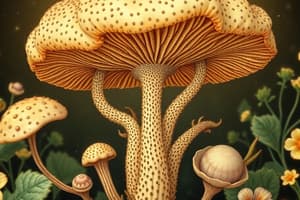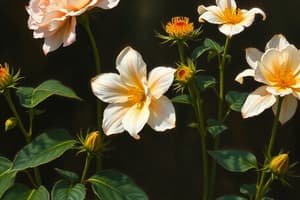Podcast
Questions and Answers
What is a characteristic that must be present for an organism to be classified as a plant?
What is a characteristic that must be present for an organism to be classified as a plant?
- Ability to reproduce asexually
- Ability to absorb oxygen
- Eukaryotic cell structure (correct)
- Presence of chloroplasts
During the alternation of generations in plants, what does the gametophyte stage produce?
During the alternation of generations in plants, what does the gametophyte stage produce?
- Diploid gametes
- Haploid gametes (correct)
- Haploid spores
- Diploid spores
Which adaptation is essential for plants to prevent water loss?
Which adaptation is essential for plants to prevent water loss?
- Production of seeds
- Development of roots
- Mycorrhizal associations
- Waxy cuticle formation (correct)
What is the role of roots in early plants before their evolution?
What is the role of roots in early plants before their evolution?
What distinguishes vascular plants from nonvascular plants?
What distinguishes vascular plants from nonvascular plants?
What is the primary function of xylem in plants?
What is the primary function of xylem in plants?
Which statement correctly differentiates gymnosperms from angiosperms?
Which statement correctly differentiates gymnosperms from angiosperms?
What type of root system is typically found in monocots?
What type of root system is typically found in monocots?
What feature distinguishes dicots from monocots in terms of flower structure?
What feature distinguishes dicots from monocots in terms of flower structure?
What is the main purpose of flowering plants (angiosperms) developing fruit?
What is the main purpose of flowering plants (angiosperms) developing fruit?
What are the primary groups into which seedless plants are divided?
What are the primary groups into which seedless plants are divided?
Which of the following are examples of nonvascular seedless plants?
Which of the following are examples of nonvascular seedless plants?
How is water transported in nonvascular plants?
How is water transported in nonvascular plants?
What characteristic distinguishes vascular plants from nonvascular plants?
What characteristic distinguishes vascular plants from nonvascular plants?
Which plant group is considered the most primitive?
Which plant group is considered the most primitive?
What limits the size of nonvascular plants?
What limits the size of nonvascular plants?
Which type of plant evolved from nonvascular seedless plants?
Which type of plant evolved from nonvascular seedless plants?
Which of the following is NOT a feature of bryophytes?
Which of the following is NOT a feature of bryophytes?
Flashcards
Gametophyte
Gametophyte
A haploid individual that produces gametes (sex cells) in the life cycle of a plant.
Sporophyte
Sporophyte
A diploid individual that produces haploid spores through meiosis in the life cycle of a plant.
Cuticle
Cuticle
A waxy, watertight covering on plants that helps prevent water loss.
Mycorrhizae
Mycorrhizae
Signup and view all the flashcards
Nonvascular Plants
Nonvascular Plants
Signup and view all the flashcards
What does Xylem transport?
What does Xylem transport?
Signup and view all the flashcards
What does Phloem transport?
What does Phloem transport?
Signup and view all the flashcards
What is a gymnosperm?
What is a gymnosperm?
Signup and view all the flashcards
What is an angiosperm?
What is an angiosperm?
Signup and view all the flashcards
What is a monocot?
What is a monocot?
Signup and view all the flashcards
Seedless Plants
Seedless Plants
Signup and view all the flashcards
Bryophytes
Bryophytes
Signup and view all the flashcards
Vascular Plants
Vascular Plants
Signup and view all the flashcards
Xylem
Xylem
Signup and view all the flashcards
Phloem
Phloem
Signup and view all the flashcards
Seedless Vascular Plants
Seedless Vascular Plants
Signup and view all the flashcards
Osmosis
Osmosis
Signup and view all the flashcards
Study Notes
Plant Diversity
- Plants are multicellular eukaryotic organisms.
- Their cell walls are made of cellulose.
- Plants are autotrophic, meaning they produce their own food through photosynthesis.
Plant Life Cycles
- Plants, like protists and fungi, exhibit alternation of generations in their life cycles.
- They have both haploid and diploid stages.
- These stages have specific names in plants.
- Gametophyte: a haploid individual producing gametes.
- Sporophyte: a diploid individual producing haploid spores via meiosis.
- Spores grow into gametophytes, completing the cycle.
Plant Evolution
- The first plants evolved from algae.
- Algae live entirely in water, while plants adapted to live on land.
- Land plants needed three key adaptations:
- Absorb nutrients from their surroundings. Plants evolved roots to do this.
- Prevent water loss: Plants evolved a waxy, watertight covering called a cuticle.
- Disperse themselves across dry land. This can happen by wind, water, or other organisms.
Plant Groups
- Plants evolved into four main groups. These are classified through nonvascular, seedless vascular, seed, and flowering.
- Ancestral green algae are their common ancestor.
- Seedless vascular plants include; Mosses, Liverworts, Hornworts, Lycophytes, Pterophytes (whisk ferns, ferns, horsetails, quillworts).
- Seed plants include Gymnosperms and Angiosperms.
- Gymnosperms are cone-bearing, produce seeds without enclosing fruit.
- Angiosperms are flowering plants that produce seeds enclosed within fruit.
- Gymnosperm = “naked seed”
- Angiosperm = “covered seed”
Seedless Plants
- Seedless plants are considered the most primitive type of plant.
- They are divided into two groups: nonvascular and vascular.
Nonvascular Plants (Bryophytes)
- Nonvascular plants lack vascular tissue (veins) for transporting water.
- Water travels through osmosis and diffusion, limiting their size.
- Examples include mosses, liverworts, and hornworts.
Vascular Plants
- Vascular plants contain vascular tissue for efficient transport of water and nutrients.
- This allows them to grow taller.
- Two types of vascular tissue:
- Xylem: transports water.
- Phloem: transports food (sugars and nutrients).
Seed Plants - Groups
- Seed plants are vascular and produce seeds to aid in their offspring's dispersal and survival.
- Classified into two main groups: gymnosperms and angiosperms.
- The key difference is how they develop their seeds (gymnosperms are "naked seeds" and angiosperms have a fruit enclosing their seeds).
Gymnosperms
- Gymnosperms are cone-bearing plants, including conifers.
- They do not have fruit enclosing their seeds.
Angiosperms
- Angiosperms reproduce using flowers, making them flowering plants.
- Their flowers attract insects and animals for pollination.
- Ovaries develop into fruit that aids in seed dispersal.
- Angiosperms are divided into two classes based on seed structure: monocots and dicots.
Classifying Angiosperms
- Monocots have one seed leaf (cotyledon).
- Dicots have two seed leaves.
Monocots vs. Dicots
- Monocots typically exhibit parallel venation (veins run parallel to each other in the leaves), while dicots have net venation (veins form a net pattern).
- Monocot flowers usually have parts in multiples of three, while dicots tend to have parts in multiples of four or five.
- Monocots typically have fibrous root systems, whereas dicots usually have a taproot.
Studying That Suits You
Use AI to generate personalized quizzes and flashcards to suit your learning preferences.




